

Paul Van Hoeydonck. Paul Van Hoeydonck (born 1925) is a Belgian printmaker and painter.
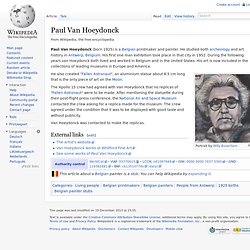
He studied both archeology and art history in Antwerp, Belgium. His first one man exhibition took place in that city in 1952. During the following years van Hoeydonck both lived and worked in Belgium and in the United States. His art is now included in the collections of leading museums in Europe and America. He also created "Fallen Astronaut", an aluminium statue about 8.5 cm long that is the only piece of art on the Moon. The Apollo 15 crew had agreed with Van Hoeydonck that no replicas of "Fallen Astronaut" were to be made. Van Hoeydonck was contacted to make the replicas. Jean Arp. Jean Arp / Hans Arp (16 September 1886 – 7 June 1966) was a German-French, or Alsatian, sculptor, painter, poet and abstract artist in other media such as torn and pasted paper.

When Arp spoke in German he referred to himself as "Hans", and when he spoke in French he referred to himself as "Jean". Many people believe that he was born Hans and later changed his name to Jean, but this is not the case. Early life[edit] Arp was born in Strasbourg as the son of a French mother and a German father, during the period following the Franco-Prussian War when the area was known as Alsace-Lorraine (Elsass-Lothringen in German) after France had ceded it to Germany in 1871. Following the return of Alsace to France at the end of World War I, French law determined that his name become Jean. In 1904, after leaving the École des Arts et Métiers in Strasbourg, he went to Paris where he published his poetry for the first time. Robert Rauschenberg. Robert Rauschenberg (October 22, 1925 – May 12, 2008) was an American painter and graphic artist whose early works anticipated the pop art movement.

Rauschenberg is well known for his "Combines" of the 1950s, in which non-traditional materials and objects were employed in innovative combinations. Jasper Johns. Detail of Flag (1954-55).
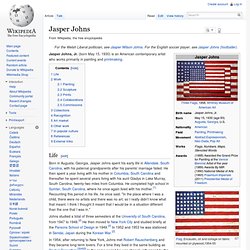
Museum of Modern Art, New York City. This image illustrates Johns' early technique of painting with thick, dripping encaustic over a collage made from found materials such as newspaper. This rough method of construction is rarely visible in photographic reproductions of his work. Jasper Johns, Jr. (born May 15, 1930) is an American contemporary artist who works primarily in painting and printmaking. Eduardo Paolozzi. Sir Eduardo Luigi Paolozzi KBE RA (7 March 1924 – 22 April 2005) was a Scottish sculptor and artist.
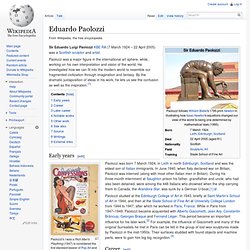
Paolozzi was a major figure in the international art sphere, while, working on his own interpretation and vision of the world. He investigated how we can fit into the modern world to resemble our fragmented civilization through imagination and fantasy. Independent Group. The Independent Group (IG) met at the Institute of Contemporary Arts (ICA) London from 1952-55.
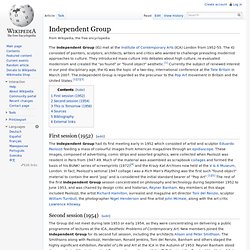
The IG consisted of painters, sculptors, architects, writers and critics who wanted to challenge prevailing modernist approaches to culture. They introduced mass culture into debates about high culture, re-evaluated modernism and created the "as found" or "found object" aesthetic.[1] Currently the subject of renewed interest in our post disciplinary age, the IG was the topic of a two-day, international conference at the Tate Britain in March 2007. The Independent Group is regarded as the precursor to the Pop Art movement in Britain and the United States.[1][2][3] First session (1952)[edit] Second session (1954)[edit] The Group did not meet during late 1953 or early 1954, as they were concentrating on delivering a public programme of lectures at the ICA, Aesthetic Problems of Contemporary Art.
This Is Tomorrow (1956)[edit] Sources[edit] Marcel Duchamp. Marcel Duchamp (French: [maʁsɛl dyʃɑ̃]; 28 July 1887 – 2 October 1968) was a French-American painter, sculptor, chess player, and writer whose work is associated with Dadaism[1][2] and conceptual art,[3] although not directly associated with Dada groups.
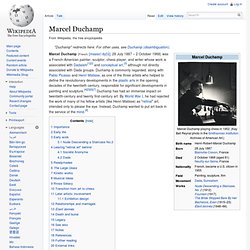
About. Pop art is an art movement that emerged in the mid-1950s in Britain and in the late 1950s in the United States.[1] Pop art presented a challenge to traditions of fine art by including imagery from popular culture such as advertising, news, etc.
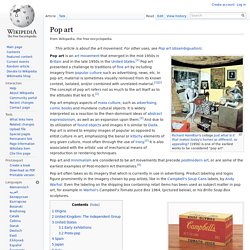
In pop art, material is sometimes visually removed from its known context, isolated, and/or combined with unrelated material.[1][2] The concept of pop art refers not as much to the art itself as to the attitudes that led to it.[2] Pop art employs aspects of mass culture, such as advertising, comic books and mundane cultural objects. It is widely interpreted as a reaction to the then-dominant ideas of abstract expressionism, as well as an expansion upon them.[3] And due to its utilization of found objects and images it is similar to Dada.